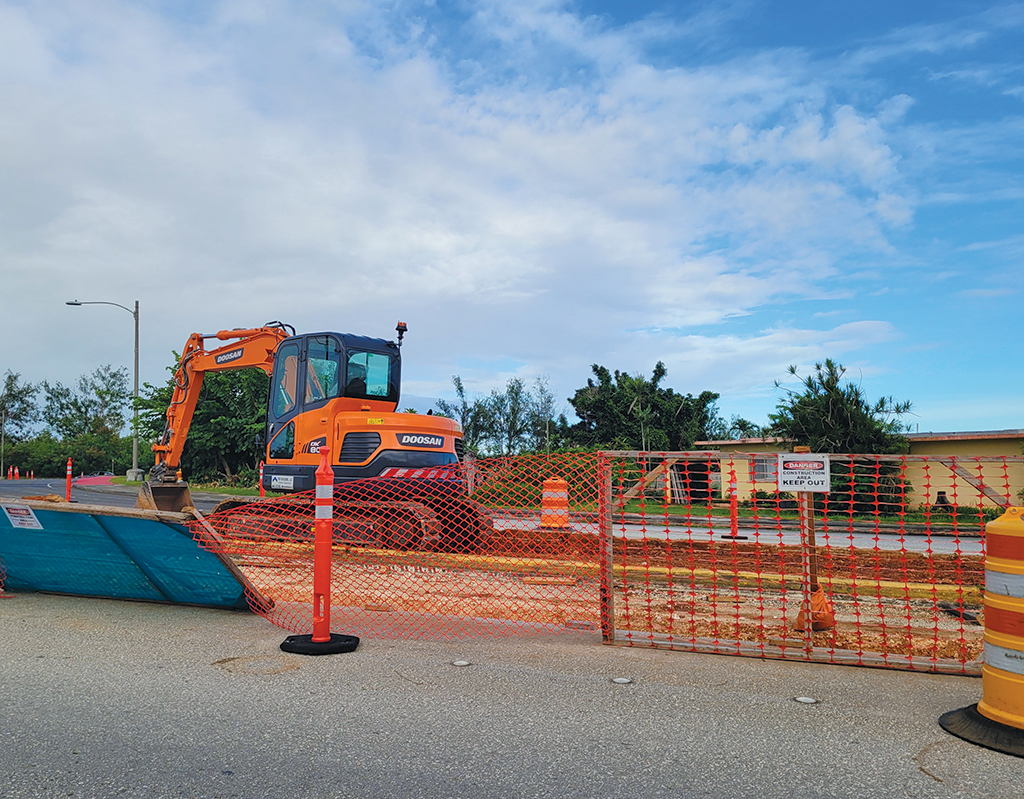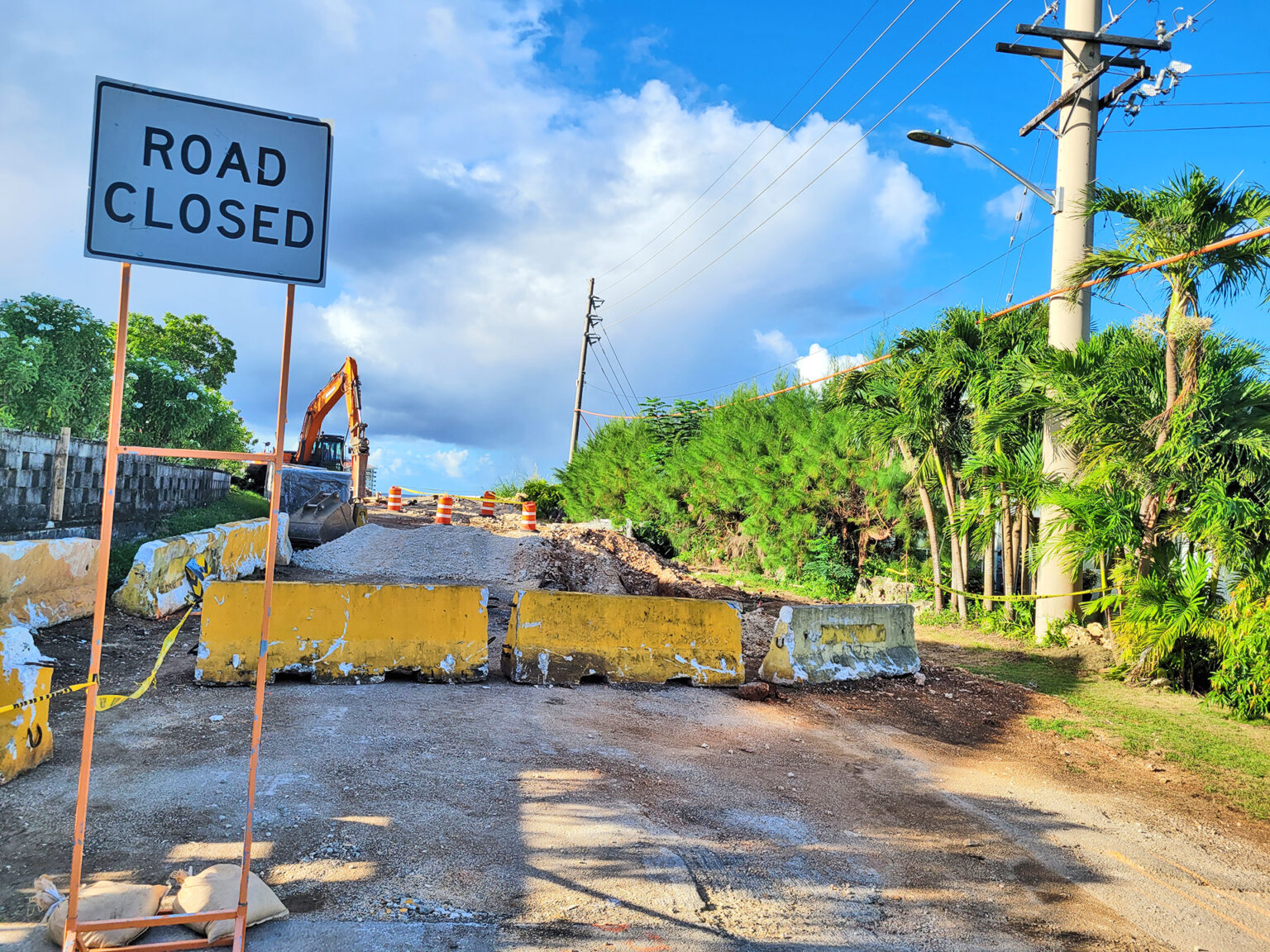O
ver the next four years, Guam residents will see roads widened, dirt streets paved and bridges rehabilitated. More than a dozen projects are either in the pipeline or close to completion under the Guam Department of Public Works’ new Guam Transportation Improvement Program (GTIP), which aims to accommodate an expected increase of vehicles on the island.
“The GTIP is a four-year plan, which is a planning document that is revised as needed based on these challenges, and program and project priorities were reassessed to meet current needs,” explains Linda Ibanez, DPW’s chief of operations.
According to a September announcement, the department’s list of 14 projects is “a product of a consensus-building process with decision-making supported by data-driven analysis.” Each project is being planned in collaboration with local villages, utility providers and local and federal government agencies.
THE PROJECTS
The projects aim to address safety issues, including flooding on Guam’s roadway system and deteriorating pavement and bridge conditions, as well as provide operational improvements.
Ibanez says the 2024-2027 GTIP is expected to be finalized this month after a series of public hearings that began in September. She says the list also includes ongoing projects covered by the last GTIP for fiscal years 2019 through 2023.
“All projects in the GTIP serve a prioritized need to support the needs of DPW roads,” Ibanez says.
Among the active projects is a $23 million, islandwide village streets pavement resurfacing effort undertaken by Hawaiian Rock Products, which is approximately 58 percent complete. Another $12.5 million project to widen Routes 5 and 12 on the island was contracted to InfraTech International LLC, and is approximately 31 percent complete.
Some existing projects are close to full completion, including the $6.5 million Route 28 rehabilitation from Route 1 to Bumachachu Road. Also contracted to Hawaiian Rock Products, that project is 99 percent complete as this issue goes to press. And a $1 million islandwide guardrail repair and replacement, commissioned to Guam-based Highway Safety Services, is 85 percent complete.
“A majority of funding received is from the [Federal Highway Administration] as part of annual allocations, which is non-discretionary,” Ibanez says.
Besides the FHWA, other funding sources include 2021’s Infrastructure Investment and Jobs Act, Grant Anticipation Revenue Vehicles (aka GARVEE bonds), Defense Access Road program funding and other federal grant programs. The department estimates it will obtain a total of $340.7 million from these funding sources.
NEW LAW MOTIVATES CHANGE
The GTIP was prepared in compliance with the requirements of the Bipartisan Infrastructure Investment and Jobs Act, also known as the Bipartisan Infrastructure Deal, the Biden administration’s centerpiece program to “rebuild America’s roads, bridges and rails [and] expand access to clean drinking water, ensure every American has access to high-speed internet, tackle the climate crisis, advance environmental justice and invest in communities that have too often been left behind.”
According to the DPW’s fact sheet, a total of $302.4 million is headed to Guam, with nine specific projects earmarked for funding.
“Since the Bipartisan Infrastructure Law passed, approximately $35.2 million has been announced for transportation — to invest in roads, bridges, public transit, ports and airports — and roughly $70 million has been announced for clean water,” Guam’s DPW says in a fact sheet. “The law will rebuild Guam roads and include the single largest dedicated bridge investment since the construction of the interstate highway system.”
Based on formula funding, the department said Guam is expected to receive approximately $96 million over five years in federal funding for highways and bridges. To date, $18.4 million has been announced for projects on Guam to help pay for construction of roads, bridges, roadway safety and other major projects.
Ibanez says the GTIP is an adjunct to the 2030 Guam Transportation Plan, a 20-year transportation strategy, which was finalized in December 2008 and presented a long-term strategy to improve transportation throughout the island.
The plan forecasted traffic growth through 2030 and included impacts associated with the relocation of 5,000 Marines — and approximately 9,000 dependents — from Okinawa to Guam. Under the original plan, 9,000 Marines and 15,000 dependents were to relocate to Guam, but opposition from the local community prompted the U.S. Department of Defense to scale down that number.
DPW has since reassessed its traffic projections and updated its 2030 master plan. While some projects are making progress, Ibanez says future building will be confronted by several challenges, such as inflation.
“The last GTIP (2019-2023) spanned the pandemic and a period in which record inflation was experienced,” Ibanez says.

More than a dozen projects are either in the pipeline or close to
completion under the Guam Transportation Improvement Program.
PHOTO BY MAR-VIC CAGURANGAN
MORE CHALLENGES REMAIN
A lingering challenge is the perennial labor shortage on Guam. The local construction industry relies on H-2B (guest) workers from the Philippines. In 2015, the federal government lifted Guam’s exemption from the 66,000-person national quota for the H-2B program.
In 2018, the National Defense Authorization Act (NDAA) eased the restrictions and allowed the hiring of more guest workers for Guam defense projects. The succeeding NDAA expanded the authorization for H-2B hiring by allowing construction companies to hire guest workers for projects supporting the military buildup, such as housing construction.
In 2022, the military spending policy law added an exemption to the H-2B visa cap to include companies that proved they were “adversely affected” by military construction. Yet a majority of Guam-bound guest workers continue to pick up jobs for defense projects.
The Marines’ relocation to Guam entails $12 billion worth of these type of projects.
“Due to the large size of ongoing military buildup projects, much more labor is required for these projects, which outcompete smaller DPW projects,” Ibanez says. “This GTIP also concurrently spanned the initial peak in military buildup spending that caused significant competition with DPW’s road program.”
The Department of Defense is undertaking its own $12.5 million road project on Route 5, funded by the FHWA, to rehabilitate and widen the road leading to the Naval Base Ordnance Annex. The project, which broke ground in June 2022, begins at Guam’s Route 2A and Route 5 intersection and continues to Route 12 and past Route 17 at Cross Island Road.
Guam congressional delegate James Moylan is pushing for the extension of the visa cap exemption for Guam.
Such a proposal, Moylan says, is the “first hurdle” to overcome in Congress.
In the meantime, local government is beefing up its apprenticeship programs to build a pool of skilled labor on Guam.
“DPW receives grants for on-the-job training that funds training for those wanting to get into construction labor occupations,” says Ibanez.




